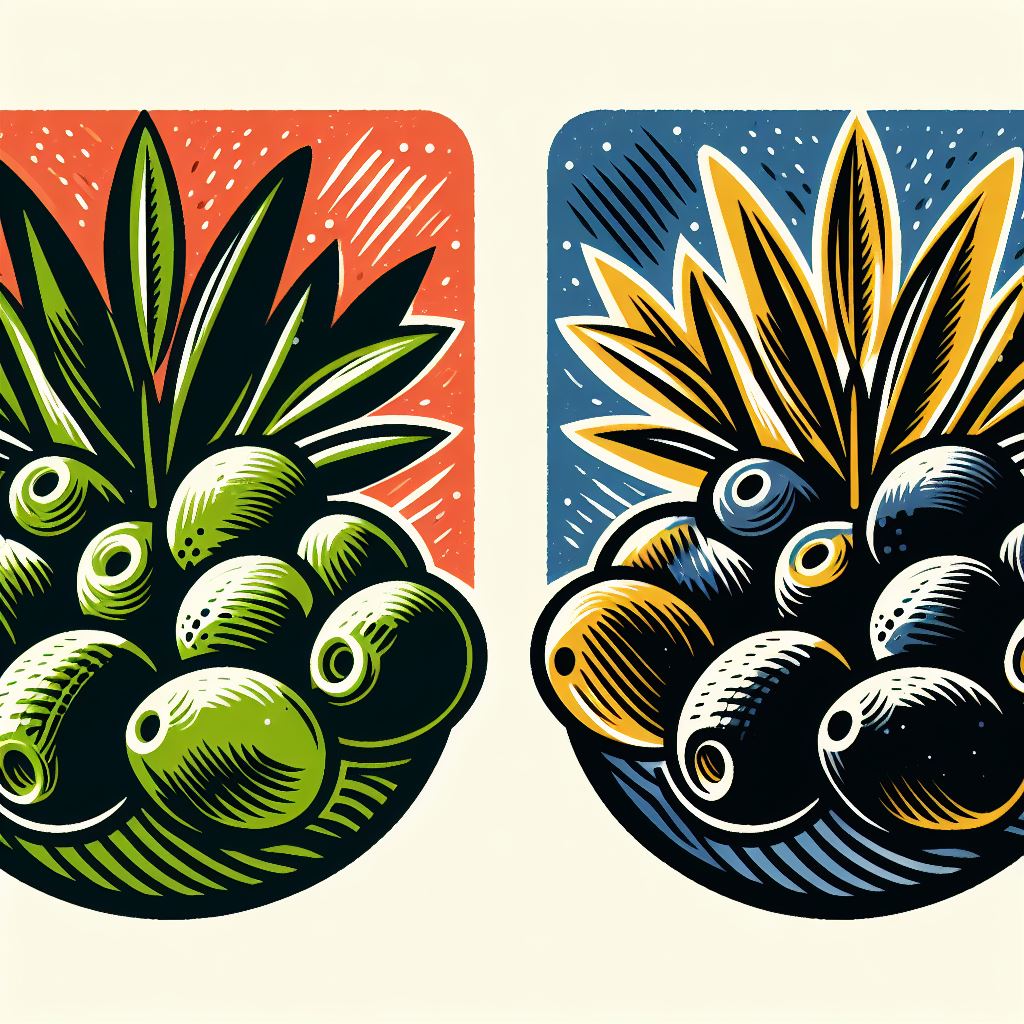In a world brimming with culinary dichotomies—fork versus spoon, butter versus margarine, to dunk or not to dunk (one’s cookies in milk, that is)—the debate between green olives and black olives perches quietly, awaiting its turn in the spotlight. It’s a contrast not just of color but of taste, texture, and the very essence of olivity.
Green olives, plucked from the tree while still young and full of vim, possess a vigor that belies their small size. Their flavor, a complex ballet of bitter and salty notes, dances on the palate, leaving a lingering impression mirrored only by the memory of a first love or a particularly stunning sunset. In comparison, black olives, allowed to bask in the sun until they reach their zenith of ripeness, offer a softer, more mellow taste—a warm hug in contrast to the green olive’s brisk handshake.
Table of Contents
The Tale of Two Olives
To truly appreciate the nuances between these two olive camps, one must venture beyond the superficial differences and into the heart—the very nucleus—of what makes each unique.
Texture and Taste Table
| Attribute | Green Olives | Black Olives |
|---|---|---|
| Texture | Firmer, Crunchier | Softer, More Yielding |
| Flavor | Brighter, Tangy, More Bitter | Richer, Milder, Slightly Sweet |
Indeed, the disparity in their maturation stages imparts distinct characteristics, akin to comparing a vivacious teenager to a worldly adult. But to pigeonhole them thus would be to ignore the spectrum of varieties each category encompasses, from the meaty Manzanilla to the robust Kalamata.
Nutritional Nuances Table
| Nutrient | Green Olives (100g) | Black Olives (100g) |
|---|---|---|
| Calories | 145 | 115 |
| Fat | 15g | 11g |
| Sodium | 1556mg | 735mg |
| Fiber | 3.3g | 2.5g |
While seemingly minor, these differences highlight the impact of harvesting time on nutritional content, underscoring the green olive’s penchant for absorbing its brine’s saltiness, a testament to its unyielding nature even in preservation.
My Accidental Experiment
Once, during an impromptu kitchen experiment fueled by curiosity and a questionable amount of wine, I endeavored to substitute black olives for green in a tapenade. The result was akin to casting a jazz musician in a classical quartet—unexpectedly harmonious but undeniably off-script. The tapenade, much like my guests, was politely perplexed, its identity crisis manifesting in a spread that was neither here nor there.
This culinary misadventure serves as a metaphor for the olives themselves: interchangeable on the surface, yet fundamentally unique in essence and best appreciated in their native contexts.
Sprinkling of Science
The divergence in taste and nutrition between green and black olives can be traced back to their ripeness at harvest. Green olives, harvested before they ripen, contain more oleuropein, a compound responsible for their characteristic bitterness. This compound gradually decreases as the olive matures, explaining the milder demeanor of the black olive.
Furthermore, the method of curing—whether in brine, water, or dry salt—plays a significant role in shaping the olive’s final flavor profile, acting as a culinary crucible that transforms the raw fruit into the nuanced nibbles we cherish.
Orchard of Inquiry
Q1: Can one substitute green olives for black in recipes?
- A1: While culinary rules are meant to be broken (or at least bent), consider the impact on flavor dynamics. A substitution may lead to an unexpected guest at the flavor party.
Q2: Why are some black olives sold canned while others are found in jars?
- A2: The vessel often reflects the curing process. Canned olives undergo heat treatment not required for jarred ones, which can affect texture and taste.
Q3: Are all black olives ripe green olives?
- A3: In essence, yes. Black olives have simply had more sun vacations, maturing to their dusky hue and milder demeanor.
Q4: How does one reduce the sodium content in olives?
- A4: Rinsing olives under cold water before use can wash away some of their saltiness, like a spa treatment for your olives.
Q5: Is there a difference in health benefits between the two?
- A5: Both varieties boast heart-healthy fats and antioxidants, though green olives edge ahead slightly in dietary fiber. Like choosing between running and swimming, both are commendable; it’s the execution that differs.
Wrapping Up
The tale of green versus black olives is a narrative rich in history, science, and gastronomy—a microcosm of the culinary world’s broader debates. Whether you lean towards the youthful exuberance of the green or the matured grace of the black, the olive branch extends far beyond mere color distinctions.
In the end, the olive, regardless of its stage of ripeness, remains a symbol of peace, a reminder that in the vast orchard of human experience, diversity in taste, texture, and tradition is not just inevitable but invaluable. Here’s to the olives, in all their glorious variations, and to the stories they continue to seed in the fertile ground of our culinary explorations.











